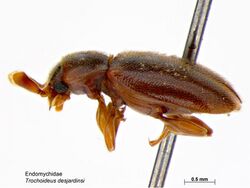Biology:Trochoideus desjardinsi
| Trochoideus desjardinsi | |
|---|---|

| |
| Scientific classification | |
| Domain: | Eukaryota |
| Kingdom: | Animalia |
| Phylum: | Arthropoda |
| Class: | Insecta |
| Order: | Coleoptera |
| Infraorder: | Cucujiformia |
| Family: | Endomychidae |
| Genus: | Trochoideus |
| Species: | T. desjardinsi
|
| Binomial name | |
| Trochoideus desjardinsi Guérin-Méneville, 1857
| |
Trochoideus desjardinsi is a species of handsome fungus beetle in the family Endomychidae.[1][2][3][4][5] It is found in Africa, North America, and Southern Asia.[1]
Distribution
The species is widely distributed in many Pacific and Indian islands and mainlands such as Andaman Islands, Borneo, Fiji, India, Java, Madagascar, Malay Peninsula, the Mascarene Islands, Myanmar, New Guinea, the Philippines, Samoa, Seychelles, Sri Lanka, Thailand. It is also introduced to Florida in the United States.[6]
Description
Typical length is about 3.0 to 4.0mm. Body elongate and parallel-sided. Dorsum consists with short dense setae. Antennae with five segments, short, and swollen as an adaptation to life with ants and termites.[7] The last antennal segment is greatly swollen in males whereas female has a sausage-shaped last antennal segment. Pronotum with lateral sulci by very shallow depressions on the basal margin. Prosternum very narrow. Tarsi are 4 segmented.[6]
Biology
Adults are considered as a minor pest of stored grain products where it feeds on the hyphae and spores of a variety of molds. They commonly inhabited in the dead leaves, in dead wood, and under bark. They are known to live in the nests of the ants Paratrechina longicornis and Anoplolepis longipes and termite species such as Macrotermes gilvus and Eurytermes ceylonicus. Adults are often collected from many economically important plants such as banana, in rotten papaya, in dead rachis of Angiopteris and rotting coconut husks. Adults are easily attracted to many light traps such as ethanol/turpentine traps, mercury vapor lights, black lights, and fluorescent light traps.[6]
References
- ↑ 1.0 1.1 "Trochoideus desjardinsi Report". https://www.itis.gov/servlet/SingleRpt/SingleRpt?search_topic=TSN&search_value=771219. Retrieved 2018-04-01.
- ↑ "Trochoideus desjardinsi species details". http://www.catalogueoflife.org/col/details/species/id/15332be5d4bd66bbb17a3cbfc3e44fa7. Retrieved 2018-04-01.
- ↑ "Trochoideus desjardinsi". https://www.gbif.org/species/1042680. Retrieved 2018-04-01.
- ↑ "Trochoideus desjardinsi Species Information". https://bugguide.net/node/view/226805. Retrieved 2018-04-01.
- ↑ "Trochoideus desjardinsi Overview". http://eol.org/pages/3217186/overview. Retrieved 2018-04-01.
- ↑ 6.0 6.1 6.2 "The Coleoptera of the Seychelles islands". https://repository.si.edu/bitstream/handle/10088/21797/ent_Shockley_2009.pdf.
- ↑ "Insects of Micronesia". http://hbs.bishopmuseum.org/pubs-online/pdf/iom16-2endo.pdf.
Further reading
- American Beetles, Volume II: Polyphaga: Scarabaeoidea through Curculionoidea. CRC Press. 2002. ISBN 978-0849309540.
- LeConte, J.L. (1861). Classification of the Coleoptera of North America. Smithsonian Miscellaneous Collections. 3. Smithsonian Institution. doi:10.5962/bhl.title.38459. ISBN 0665100558. https://www.biodiversitylibrary.org/item/85732.
- Skelley, P.E.; Burgess, G.R. (1995). "Trochoideus desjardinsi Guérin found in Florida (Endomychidae: Trochoideinae)". The Coleopterists Bulletin 49 (3): 289–291. ISSN 0010-065X.
- Skelley, Paul E.; Leschen, Richard A.B. (2002). Family 92. Endomychidae Leach 1815. American Beetles Vol. 2: Polyphaga: Scarabaeoidea through Curculionoidea. CRC Press. pp. 366–370. ISBN 0-8493-0954-9.
- Strohecker, H.F. (1986). "Family: Endomychidae". A Catalog of the Coleoptera of America North of Mexico (United States Department of Agriculture).
- Tomaszewska, K. Wioletta (2005). "Phylogeny and generic classification of the subfamily Lycoperdininae with a re-analysis of the family Endomychidae (Coleoptera: Cucujoidea)". Annales Zoologici 55. ISSN 0003-4541.
- Tomaszewska, K. Wioletta (2000). "Morphology, phylogeny and classification of adult Endomychidae (Coleoptera: Cucujoidea)". Annales Zoologici 50 (4): 449–558. ISSN 0003-4541.
- White, Richard E. (1998) [1983]. A Field Guide to the Beetles of North America (Peterson Field Guides). Houghton Mifflin Harcourt. ISBN 0395910897. https://archive.org/details/isbn_9780395910894.
External links
Wikidata ☰ Q4741425 entry
 |

